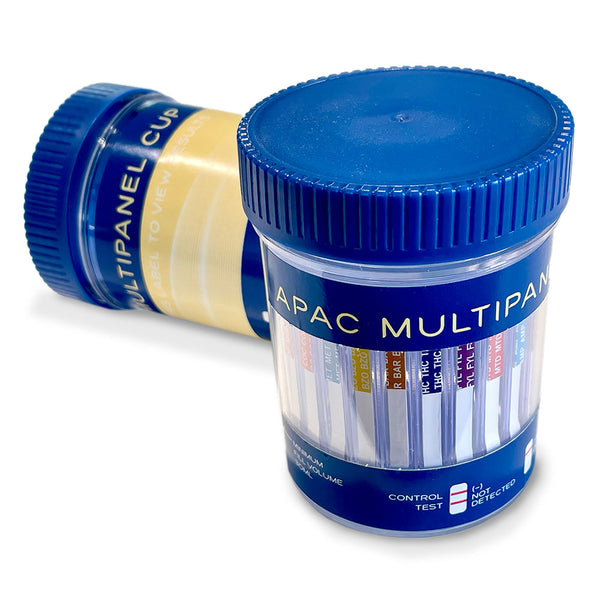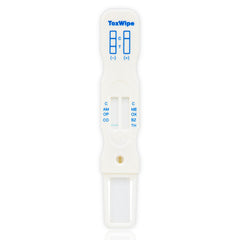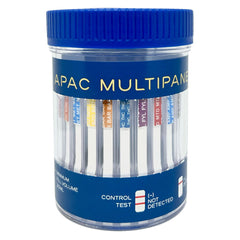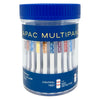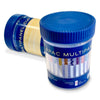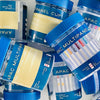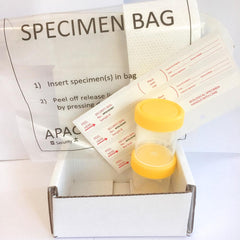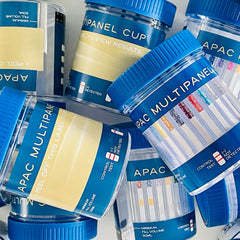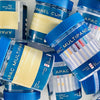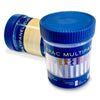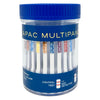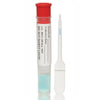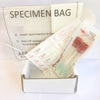APAC 9 – Nine Panel Drug Screening Cup
Product Code: AS-DT-APAC-9
Have a question?
APAC 9 – Nine Panel Drug Screening Cup
Designed by an Australian science team
In 2010, APAC Security was awarded a government contract to supply Drug of Abuse screening cups to corrections. Quite soon we realised that the configurations of the drugs were not suitable for corrections and we were not able to find any alternatives, in Australia nor Internationally. Since we had over 10 years experience from the development of the BIOSENS system, which is based on an immunoassay based technology, we decided to design our own lateral flow immunoassay cup.
How it works
An immunoassay device, like the APAC Cup, is based on the principle of developing Monoclonal Antibodies, that can detect target molecules like Methamphetamine. Inside the APAC Cup, each detectable drug is represented by a single strip that soaks up urine in a lateral flow. Once the urine “climbs” the strip, it passes through an area where the monoclonal antibodies are attached to the strip. The antibodies mix with the urine and continue to flow upwards, towards a Test line, T-line, which is coated with something similar to Methamphetamine, so called antigen. Importantly, the antigen has a weaker affinity to the antibody, meaning the antibody prefers being attached to the “real” Methamphetamine rather than weaker antigen.
If the urine contains none or low concentrations of Methamphetamine, the antibodies will bond to the antigens on the T-line. The less concentration the more antibodies that bond to the T-line. Since the antibodies have been linked with a reddish ink made from gold, you don’t actually see the antibodies but the gold colloid particles. Consequently if the urine contains Methamphetamine, the antibodies will simply pass by, the T-line, as the bonding to the real drug is stronger, meaning no line represents a positive.
The APAC Cup is quality approved
Collection and testing of drugs in urine and oral fluid (saliva) are governed by NATA, which is an Australian Authority. The urine standard is named as AS/NZS 4308:2008 and the oral fluid AS 4760:2019. The standards covers issues such as proper collection, chain of custody, initial screening, confirmation analysis and reporting of samples. The requirements for the APAC cup can be found in AS/NZS 4308:2008, Appendix B – “Verification of performance of on-site devices around Cut off”.
What drug types are tested?
The current standard only involves the six “standard” drugs and defines what concentrations should be considered as negative or non-negative (syntax is non-negative, as the sample can only be confirmed as positive after a final GCMS or LCMS confirmatory test). As one may realise it is quite important that the community agree to what should be regarded as negative/non-negative, in terms of concentrations, as shown in the table.
Because the cups are not digital e.g. providing an Opiate negative for 299 and non-negative for 301, the standard stipulates that the cup must show a negative for the cut off minus 30% and a non-negative for the cut-off plus 25%. As an example the APAC cup must display a Heroine negative for a urine concentration of 210 ng/ml (nano gram per micro litre) and below & a non-negative for a concentration of 375 ng/ml and above. Consequently, APAC Security sent a number of cups to a government laboratory who tested the cups against the cut offs. A Certificate of compliance was issued after the final test in 2016.
| Type of drug | Cut off ng/ml |
|---|---|
| Amphetamine | 300 |
| Methamphetamine | 300 |
| Benzodiacepine | 200 |
| Cocaine | 300 |
| Morphine (Heroine) | 300 |
| THC (Cannabinoids) | 50 |


